Phytosociological analysis of Quercus cerris woods in the sub-Mediterranean phytogeographical region of Slovenia / Fitocenološka analiza gozdov cera (Quercus cerris) v submediteranskem fitogeografskem območju Slovenije
DOI:
https://doi.org/10.3986/fbg0026Abstract
We conducted a phytosociological analysis of mixed deciduous forests on flysch and mixed flysch-limestone bedrock in the Central Soča Valley, the Karst, the Brkini Hills and in Slovenian Istria with dominating Quercus cerris in the upper tree layer. Based on the comparison with similar Quercus cerris communities in Slovenia, Italy, Hungary and Bosnia and Herzegovina we described a new association, Seslerio autumnalis-Quercetum cerridis, which we classified into the alliance Carpinion orientalis. We subdivided it into three subassociations: -asparagetosum acutifolii (Quercus cerris stands in Slovenian Istria where this tree species rejuvenates successfully and keeps through many generations), -hieracietosum sabaudi (a form on slightly acid flysch soil, also in Istria) and -campanuletosum rapunculoidis (a secondary Quercus cerris community on potential beech sites). Even though the described Quercus cerris stands are considered secondary (pioneer), they overgrow very large areas and we therefore propose they be classified as a new habitat and forest site type, littoral Quercus cerris woods on flysch.
Key words: phytosociology, synsystematics, Seslerio autumnalis-Quercetum cerridis, Carpinion orientalis, Istria, Slovenia
Fitocenološko smo analizirali mešane listnate gozdove na flišni in mešani flišno-apnenčasti matični podlagi v Srednjem Posočju, na Krasu, v Brkinih in v Slovenski Istri, kjer v drevesni plasti prevladuje cer (Quercus cerris). Na podlagi primerjave s podobnimi cerovimi združbami v Sloveniji, Italiji, Madžarski in Bosni in Hercegovini smo opisali novo asociacijo Seslerio autumnalis-Quercetum cerridis, ki jo uvrščamo v zvezo Carpinion orientalis. Členili smo jo na tri subasociaciji: -asparagetosum acutifolii (cerovi sestoji v Slovenski Istri, kjer se ta drevesna vrsta dobro pomlajuje in ohranja skozi več generacij), -hieracietosum sabaudi (oblika na nekoliko zakisanih flišnih tleh, prav tako v Istri) in -campanuletosum rapunculoidis (drugotna cerova združba na potencialno bukovih rastiščih). Kljub temu, da opisane cerove sestoje štejemo za drugotne (pionirske), zaradi precejšnjih površin, ki jih poraščajo, predlagamo nov habitatni in gozdni rastiščni tip primorsko cerovje na flišu.
Ključne besede: fitocenologija, sinsistematika, Seslerio autumnalis-Quercetum cerridis, Carpinion orientalis, Istra, SlovenijaDownloads
Published
Issue
Section
License
Authors who publish with this journal agree to the following terms:- Authors retain copyright and grant the journal right of first publication with the work simultaneously licensed under a Creative Commons Attribution License that allows others to share the work with an acknowledgement of the work's authorship and initial publication in this journal.
- Authors are able to enter into separate, additional contractual arrangements for the non-exclusive distribution of the journal's published version of the work (e.g., post it to an institutional repository or publish it in a book), with an acknowledgement of its initial publication in this journal.
- Authors are permitted and encouraged to post their work online (e.g., in institutional repositories or on their website) prior to and during the submission process, as it can lead to productive exchanges, as well as earlier and greater citation of published work (See The Effect of Open Access).




